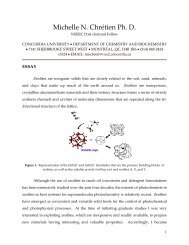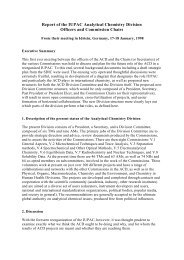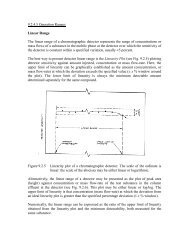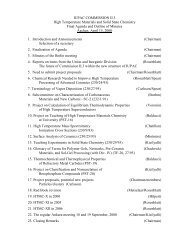9.2.3.7 Retention Parameters in Column Chromatography ... - iupac
9.2.3.7 Retention Parameters in Column Chromatography ... - iupac
9.2.3.7 Retention Parameters in Column Chromatography ... - iupac
You also want an ePaper? Increase the reach of your titles
YUMPU automatically turns print PDFs into web optimized ePapers that Google loves.
<strong>9.2.3.7</strong> <strong>Retention</strong> <strong>Parameters</strong> <strong>in</strong> <strong>Column</strong> <strong>Chromatography</strong><br />
<strong>Retention</strong> parameters may be measured <strong>in</strong> terms of chart distances or times, as well as<br />
mobile phase volumes; e.g., tR' (time) is analogous to VR' (volume). If recorder speed is<br />
constant, the chart distances are directly proportional to the times; similarly if the flow<br />
rate is constant, the volumes are directly proportional to the times.<br />
Note: In gas chromatography, or <strong>in</strong> any chromatography where the mobile phase expands<br />
<strong>in</strong> the column, VM, VR and VR' represent volumes under column outlet pressure. If Fc, the<br />
carrier gas flow rate at the column outlet and corrected to column temperature (see Flow<br />
Rate), is used <strong>in</strong> calculat<strong>in</strong>g the retention volumes from the retention time values, these<br />
correspond to volumes at column temperatures.<br />
The various conditions under which retention volumes (times) are expressed are <strong>in</strong>dicated<br />
by superscripts: thus, a prime ('; as <strong>in</strong> VR') refers to correction for the hold-up volume<br />
(and time) while a circle (º; as <strong>in</strong> VRº) refers to correction for mobile-phase compression.<br />
In the case of the net retention volume (time) both corrections should be applied:<br />
however, <strong>in</strong> order not to confuse the symbol by the use of a double superscript, a new<br />
symbol (VN, tN) is used for the net retention volume (time).<br />
Hold-up Volume (Time) (VM, tM )<br />
The volume of the mobile phase (or the correspond<strong>in</strong>g time) required to elute a<br />
component the concentration of which <strong>in</strong> the stationary phase is negligible compared to<br />
that <strong>in</strong> the mobile phase. In other words, this component is not reta<strong>in</strong>ed at all by the<br />
stationary phase. Thus, the hold-up volume (time) is equal to the <strong>Retention</strong> Volume<br />
(Time) of an Unreta<strong>in</strong>ed Compound. The hold-up volume (time) corresponds to the<br />
distance OA <strong>in</strong> Fig. 9.2.1.A and it <strong>in</strong>cludes any volumes contributed by the sample<br />
<strong>in</strong>jector, the detector, and connectors.<br />
tM = VM / Fc<br />
In gas chromatography this term is also called the Gas Hold-up Volume (Time).<br />
Corrected Gas Hold-up Volume (VM o )<br />
The gas hold-up volume multiplied by the compression (compressibility) correction<br />
factor (j):<br />
VM o = VM j<br />
Assum<strong>in</strong>g that the <strong>in</strong>fluence of extracolumn volume on VM is negligible,<br />
(see Interparticle Volume of the <strong>Column</strong>).<br />
VM o = VG
Total <strong>Retention</strong> Volume (Time) (VR, tR )<br />
The volume of mobile phase enter<strong>in</strong>g the column between sample <strong>in</strong>jection and the<br />
emergence of the peak maximum of the sample component of <strong>in</strong>terest (OB <strong>in</strong> Fig.<br />
9.2.1.A), or the correspond<strong>in</strong>g time. It <strong>in</strong>cludes the hold-up volume (time):<br />
Peak Elution Volume (Time) ( V R , t R )<br />
tR = VR / Fc<br />
The volume of mobile phase enter<strong>in</strong>g the column between the start of the elution and the<br />
emergence of the peak maximum, or the correspond<strong>in</strong>g time. In most of the cases, this is<br />
equal to the total retention volume (time). There are, however, cases when the elution<br />
process does not start immediately at sample <strong>in</strong>troduction. For example, <strong>in</strong> liquid<br />
chromatography, sometimes the column is washed with a liquid after the application of<br />
the sample to displace certa<strong>in</strong> components which are of no <strong>in</strong>terest and dur<strong>in</strong>g this<br />
treatment the sample does not move along the column. In gas chromatography, there are<br />
also cases when a liquid sample is applied to the top of the column but its elution starts<br />
only after a given period. This term is useful <strong>in</strong> such cases.<br />
Adjusted <strong>Retention</strong> Volume (Time) (VR', tR')<br />
The total elution volume (time) m<strong>in</strong>us the hold-up volume (time). It corresponds to the<br />
distance AB <strong>in</strong> Fig. 9.2.1.A:<br />
VR' = VR - VM<br />
tR' = tR - tM = (VR-VM)/Fc = VR'/Fc<br />
Corrected <strong>Retention</strong> Volume (Time) (VR o , tR o )<br />
The total retention volume (time) multiplied by the compression correction factor (j):<br />
VR o = VR j<br />
tR o = VR j/Fc = VR o /Fc<br />
Net <strong>Retention</strong> Volume (Time) (VN, tN )<br />
The adjusted retention volume (time) multiplied by the compression correction factor (j):<br />
VN = VR' j<br />
tN = VR'j/ Fc = VN /Fc<br />
In liquid chromatography, the compression of the mobile phase is negligible and thus, the<br />
compression correction factor does not apply. For this reason, the total and corrected
etention volumes (times) are identical (VR = VR o ; tR = tN) and so are the adjusted and net<br />
retention volumes (times) (VR'= VN ; tR'= tN).<br />
The specific retention volume at column temperature (Vg Θ )<br />
The net retention volume per gram of stationary phase (stationary liquid, active solid or<br />
solvent-free gel (WS ):<br />
Vg Θ = VN/WS<br />
Specific retention volume at 0°C (Vg )<br />
The value of Vg θ corrected to 0°C:<br />
θ 273.<br />
15K<br />
v<br />
V g = Vg<br />
=<br />
T W<br />
where Tc is the column temperature (<strong>in</strong> kelv<strong>in</strong>).<br />
<strong>Retention</strong> Factor (k)<br />
c<br />
N<br />
S<br />
273.<br />
15K<br />
T<br />
The retention factor is a measure of the time the sample component resides <strong>in</strong> the<br />
stationary phase relative to the time it resides <strong>in</strong> the mobile phase: it expresses how much<br />
longer a sample component is retarded by the stationary phase than it would take to travel<br />
through the column with the velocity of the mobile phase. Mathematically, it is the ratio<br />
of the adjusted retention volume (time) and the hold-up volume (time):<br />
k = VR'/VM = tR'/tM<br />
If the distribution constant is <strong>in</strong>dependent of sample component concentration, then the<br />
retention factor is also equal to the ratio of the amounts of a sample component <strong>in</strong> the<br />
stationary and mobile phases respectively, at equilibrium:<br />
amount of component <strong>in</strong> the stationary phase<br />
k =<br />
amount of component <strong>in</strong> the mobile phase<br />
If the fraction of the sample component <strong>in</strong> the mobile phase is R (see Retardation<br />
Factor), then the fraction <strong>in</strong> the stationary phase is (1 - R); thus<br />
k = (1 - R)/R<br />
Note: In former nomenclatures and <strong>in</strong> the literature one may f<strong>in</strong>d the expressions<br />
Partition Ratio, Capacity Ratio, Capacity Factor or Mass Distribution Ratio to describe<br />
this term.<br />
c
In the literature the symbol k' is often used for the retention factor, particularly <strong>in</strong> liquid<br />
chromatography. The orig<strong>in</strong>al reason for this was to clearly dist<strong>in</strong>guish it from the<br />
partition coefficient (distribution constant) for which the symbol K had been utilized.<br />
S<strong>in</strong>ce, however, the distribution constants are all identified with a subscript, there is no<br />
reason to add the prime sign to this symbol. It should be emphasized that all the<br />
recognized nomenclatures (IUPAC, BS, ASTM) have always clearly identified the<br />
capacity factor with the symbol k and not k'.<br />
Logarithm of the <strong>Retention</strong> Factor<br />
This term is equivalent to the RM value used <strong>in</strong> planar chromatography (see RM value).<br />
The symbol κ is suggested to express log k:<br />
Retardation Factor (R)<br />
κ = log k = log [(1 - R)/R]<br />
The fraction of the sample component <strong>in</strong> the mobile phase at equilibrium; it is related to<br />
the retention factor and other fundamental chromatography terms:<br />
Relative <strong>Retention</strong> (r)<br />
R = 1/(k + 1)<br />
The ratio of the adjusted or net retention volume (time) or retention factor of a<br />
component relative to that of a standard, obta<strong>in</strong>ed under identical conditions:<br />
r = VRi'/VR(st)' = VNi /VN(st) = tRi'/tR(st)' = ki /kst<br />
Depend<strong>in</strong>g on the relative position of the peak correspond<strong>in</strong>g to the standard compound<br />
<strong>in</strong> the chromatogram, the value of r may be smaller, larger or identical to unity.<br />
Separation Factor (α)<br />
The relative retention value calculated for two adjacent peaks (VR2' > VR1'):<br />
α = VR2'/VR1'= VN2/VN1 = tR2'/tR1' = k2 /k1<br />
By def<strong>in</strong>ition, the value of the separation factor is always greater than unity.<br />
The separation factor is also identical to the ratio of the correspond<strong>in</strong>g distribution<br />
constants.<br />
Note: The separation factor is sometimes also called the "selectivity". The use of this<br />
expression is discouraged.<br />
Unadjusted Relative <strong>Retention</strong> (rG or αG )
Relative retention calculated by us<strong>in</strong>g the total retention volumes (times) <strong>in</strong>stead of the<br />
adjusted or net retention volumes (times):<br />
Subscript G commemorates E. Glueckauf, who first used this expression.<br />
/ V<br />
R(st)<br />
Relative retention (r) and separation factor (α) values must always be measured under<br />
isothermal conditions. On the other hand, the unadjusted relative retention (rG or αG)<br />
values may also be obta<strong>in</strong>ed <strong>in</strong> programmed-temperature or gradient-elution conditions.<br />
Under such conditions, the symbol RRT (for Relative <strong>Retention</strong> Time) has also been used<br />
to describe the unadjusted relative retention values.<br />
Us<strong>in</strong>g the same stationary and mobile phases and temperature, the relative retention and<br />
separation factor values are reproducible between chromatographic systems. On the other<br />
hand, the unadjusted relative retention (and "relative retention time") values are only<br />
reproducible with<strong>in</strong> a s<strong>in</strong>gle chromatographic system.<br />
<strong>Retention</strong> Index; Kováts (<strong>Retention</strong>) Index (I)<br />
r<br />
G<br />
= V<br />
Ri<br />
= t<br />
The retention <strong>in</strong>dex of a sample component is a number, obta<strong>in</strong>ed by <strong>in</strong>terpolation<br />
(usually logarithmic), relat<strong>in</strong>g the adjusted retention volume (time) or the retention factor<br />
of the sample component to the adjusted retention volumes (times) of two standards<br />
eluted before and after the peak of the sample component.<br />
In the Kováts Index or Kováts <strong>Retention</strong> Index used <strong>in</strong> gas chromatography, n-alkanes<br />
serve as the standards and logarithmic <strong>in</strong>terpolation is utilized:<br />
⎡ log X<br />
I = 100⎢<br />
⎢⎣<br />
log X (<br />
z<br />
where X refers to the adjusted retention volumes or times, z is the number of carbon<br />
atoms of the n-alkane elut<strong>in</strong>g before, and (z +1) is the number of carbon atoms of the<br />
n-alkane elut<strong>in</strong>g after the peak of <strong>in</strong>terest:<br />
VRz' < VRi' < VR(z + 1)'<br />
The Kováts (<strong>Retention</strong>) Index expresses the number of carbon atoms (multiplied by 100)<br />
of a hypothetical normal alkane which would have an adjusted retention volume (time)<br />
identical to that of the peak of <strong>in</strong>terest when analyzed under identical conditions.<br />
i<br />
Ri<br />
/ t<br />
R(st )<br />
− log X z<br />
− log X<br />
+ 1)<br />
ki<br />
+ 1<br />
=<br />
k + 1<br />
z<br />
st<br />
⎤<br />
+ z⎥<br />
⎥⎦
The Kováts <strong>Retention</strong> Index is always measured under isothermal conditions. In the case<br />
of temperature-programmed gas chromatography a similar value can be calculated<br />
utiliz<strong>in</strong>g direct numbers <strong>in</strong>stead of their logarithm. S<strong>in</strong>ce both the numerator and<br />
denom<strong>in</strong>ator conta<strong>in</strong> the difference of two values, here we can use the total retention<br />
volumes (times).<br />
Sometimes this value is called the L<strong>in</strong>ear <strong>Retention</strong> Index:<br />
⎡ t<br />
= 100<br />
⎢ T<br />
⎢⎣<br />
t<br />
T<br />
− tRz<br />
− t<br />
Τ<br />
I<br />
T<br />
Ri<br />
T<br />
R(z−1)<br />
Rz<br />
⎤<br />
+ z⎥<br />
⎥⎦<br />
where tR T refers to the total retention times (chart distances) measured under the<br />
conditions of temperature programm<strong>in</strong>g. The value of I T will usually differ from the<br />
value of I measured for the same compound under isothermal conditions, us<strong>in</strong>g the same<br />
two phases.
















